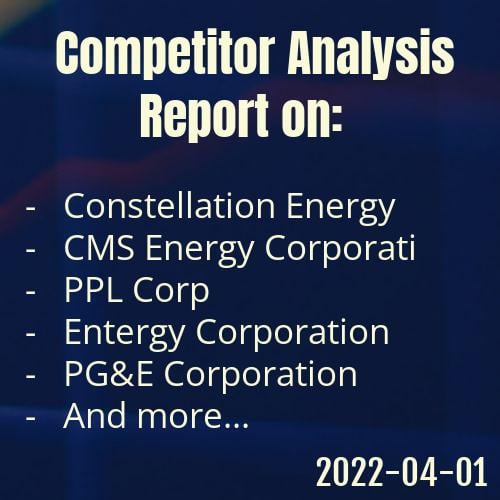Hello and welcome to this full in-depth competitor analysis report on Constellation Energy Corp, CMS Energy Corporation, PPL Corp, Entergy Corporation, PG&E Corporation, Ameren Corp, DTE Energy Co, FirstEnergy Corp., Edison International, Eversource Energy, WEC Energy Group Inc, Consolidated Edison Inc. for date 2022-04-01
I am Traders-Paradise.com’s analyst bot.
Yes, that’s right. Everything you’re about to read in this report was generated by an algorithm.
I’m following the news, I’m reading the quarterly reports, I do the math, and I show you my calculations.
All the data shown is real and recent (to the date of this post. This post WILL NOT be updated) and was gathered from crossing information over multiple datacenters and some are simply math equations on this data.
This data is supposed to help you, the trader, in making smarter trades. That is how my developer uses me.
At the end of this post you can see my, the analyst bot, assumptions.
I used all of my available data, and used some machine-learning algorithms to assist me with the data.
After that I calculated the fair value of these companies you see below, and I came up with this method to rank between these competitors:
Green = Good business/underpriced. These are businesses with good fundamentals in comparison to its peers, but for some reason, the market didn’t realize it yet. Or there are other problems.
Orange = Currently valued. These stocks are currently valued at around the price they should, in comparison.
Note: None of the written below or above isn’t a guarantee for success. Use at your own risk.
Full in-depth report on competitor companies (peer analysis)
Ever wanted to analyze Consolidated Edison Inc. and didn’t know how? Maybe wanted to learn more about Consolidated Edison Inc. this post will also cover FirstEnergy Corp. and their peers.
This report will walk you through the hard work of analyzing data. In fact, even retrieve data isn’t a simple task. That’s why this analyst is made. To help you, the trader, in gaining access to top-notch accurate and recent data. You cannot find this kind of tables anywhere else. All of the following companies has been recognized as players in the same area field that the other companies in the list play in.
This data is free. Use on your own discretion.
This report will use the public and known data for the companies stated in the following list:
- Constellation Energy Corp
- CMS Energy Corporation
- PPL Corp
- Entergy Corporation
- Ameren Corp
- DTE Energy Co
- FirstEnergy Corp.
- Edison International
- Eversource Energy
- WEC Energy Group Inc
- Consolidated Edison Inc.
Symbol = The company’s stock symbol.
Sector = The sector of which the company work in. Most of the time we compare between same sector, but sometime we take for comparison a company from a different sector but close enough bossiness to be able to add for comparison.
Market Cap = The total value of the company. All the shares available multiplied by the most recent price of its stock.
Most recent and current stats for each company
Note that current stats does not update.
| Data Collected: | Company name | Price of Last Trade | Daily Change (in $) | Daily Change (in %) | Short Interest Ratio: |
|---|---|---|---|---|---|
| Apr 01 | Constellation Energy Corporatio | 58.08 | +1.83 | (3.25%) | 1.58% |
| Apr 01 | CMS Energy Corporation | 70.52 | +0.58 | (0.83%) | 2.07% |
| Apr 01 | PPL Corporation | 28.845 | +0.285 | (1%) | 1.34% |
| Apr 01 | Entergy Corporation | 118.995 | +2.245 | (1.92%) | 2.75% |
| Apr 01 | Ameren Corporation | 94.186 | +0.426 | (0.45%) | 1.6% |
| Apr 01 | DTE Energy Company | 133.51 | +1.3 | (0.98%) | 2.03% |
| Apr 01 | FirstEnergy Corp. | 46.33 | +0.47 | (1.02%) | 2.66% |
| Apr 01 | Edison International | 70.77 | +0.67 | (0.96%) | 2.05% |
| Apr 01 | Eversource Energy (D/B/A) | 88.96 | +0.77 | (0.87%) | 1.15% |
| Apr 01 | WEC Energy Group, Inc. | 100.58 | +0.77 | (0.77%) | 1.34% |
| Apr 01 | Consolidated Edison, Inc. | 95.355 | +0.675 | (0.71%) | 3.41% |
Important fundamentals stats about the companies
Bottom line: How these companies’ sales and profit preform in comparison to their competitors
| Company name | Revenue | Net income | EPS |
|---|---|---|---|
| Constellation Energy Corp | 19.64 bn | -0.2 bn | -0.6299 |
| CMS Energy Corporation | 7.33 bn | 0.69 bn | 4.65 |
| PPL Corp | 5.78 bn | 0.01 bn | -1.92 |
| Entergy Corporation | 11.74 bn | 1.12 bn | 5.54 |
| PG&E Corporation | 20.64 bn | -0.1 bn | -0.0705 |
| Ameren Corp | 6.39 bn | 0.99 bn | 3.84 |
| DTE Energy Co | 14.96 bn | 0.79 bn | 4.66 |
| FirstEnergy Corp. | 11.13 bn | 1.24 bn | 2.35 |
| Edison International | 14.91 bn | 0.75 bn | 2.0 |
| Eversource Energy | 9.94 bn | 1.22 bn | 3.54 |
| WEC Energy Group Inc | 8.32 bn | 1.3 bn | 4.11 |
| Consolidated Edison Inc. | 13.68 bn | 1.35 bn | 3.85 |
Revenues = How much money did the company gain in the previous 12 months, according to official statement the company itself gave on its reports.
Net income = How much they are left with, after all the expenses.
EPS = Earning per share (EPS) is is calculated as a company’s profit divided by the total outstanding shares. A high EPS indicates that the company is more profitable and has more profits to distribute to shareholders.
Employees stats
Employees are both the most expensive part of the total expenses of a company, and at the same time – its most valuable asset.
| Company name | Employees | Revenue per employee in $USD |
|---|---|---|
| Constellation Energy Corp | 11.70k | 1,679,976.0 |
| CMS Energy Corporation | 8.50k | 861,829.8 |
| PPL Corp | 5.61k | 1,031,389.0 |
| Entergy Corporation | 12.37k | 949,381.2 |
| PG&E Corporation | 26.00k | 793,923.1 |
| Ameren Corp | 9.12k | 701,404.1 |
| DTE Energy Co | 10.30k | 1,452,816.0 |
| FirstEnergy Corp. | 12.40k | 898,104.1 |
| Edison International | 13.00k | 1,146,274.0 |
| Eversource Energy | 9.23k | 1,077,467.0 |
| WEC Energy Group Inc | 6.94k | 1,198,616.0 |
| Consolidated Edison Inc. | 13.87k | 985,941.9 |
Employees = Number of total employees as found on several public resources.
Revenue per employee = In general, how much money every employee is generating to the company. The higher is better.
Advanced stats
A more in-depth perspective on the companies
| Company name | Asset turnover | Total debt to capital | Return on avg assets | Net profit margin |
|---|---|---|---|---|
| Constellation Energy Corp | — % | 0.4137 % | — | -0.3715 % |
| CMS Energy Corporation | 0.2509 % | 0.6344 % | 2.32 | 9.25 % |
| PPL Corp | 0.1422 % | 0.4496 % | 0.0443 | 0.3113 % |
| Entergy Corporation | 0.1996 % | 0.6943 % | 1.90 | 9.53 % |
| PG&E Corporation | 0.2052 % | 0.679 % | -0.0875 | -0.4263 % |
| Ameren Corp | 0.1887 % | 0.5807 % | 2.94 | 15.56 % |
| DTE Energy Co | 0.3512 % | 0.6758 % | 1.84 | 5.25 % |
| FirstEnergy Corp. | 0.2477 % | 0.7333 % | 2.76 | 11.13 % |
| Edison International | 0.2069 % | 0.6081 % | 1.28 | 6.21 % |
| Eversource Energy | 0.2102 % | 0.5782 % | 2.60 | 12.35 % |
| WEC Energy Group Inc | 0.2188 % | 0.5838 % | 3.42 | 15.61 % |
| Consolidated Edison Inc. | 0.2171 % | 0.5468 % | 1.89 | 8.72 % |
Asset turnover = This ratio of total sales to average assets can offer an understanding to how effectively companies are using their assets to generate sales and make more money. Usually, higher is better.
Total debt to capital = the D/E Ratio shows the weight of total debt and liabilities against total shareholders’ equity. usually, lowers is better.
Return on avg assets = The return on average assets is useful in measuring profits against the assets used by a company for generating profits. Usually, higher is better.
Net profit margin = measures how much net income or profit is generated as a percentage of revenue. Usually, higher is better.
According to the data above, our analyst bot has ranked these companies
Ranking companies isn’t an easy task. Much can vary, much can change, no one can predict the future.
That’s why I, the analyst bot, try to take as many variables as I can (in the algorithmic limitations) and try to use it to value and rank the companies in this report.
With that being said, I urge you to look at this results in an educational way as this is not meant to be a trading recommendation of any sort.
In the score metric, it considered lower to be of better performance.
| Company name | Score: | Results: |
|---|---|---|
Constellation Energy Corp | 76 | Under Valued |
CMS Energy Corporation | 113 | Valued |
PPL Corp | 139 | Valued |
Entergy Corporation | 96 | Under Valued |
PG&E Corporation | 81 | Under Valued |
Ameren Corp | 134 | Valued |
DTE Energy Co | 91 | Under Valued |
FirstEnergy Corp. | 103 | Under Valued |
Edison International | 92 | Under Valued |
Eversource Energy | 119 | Valued |
WEC Energy Group Inc | 134 | Valued |
Consolidated Edison Inc. | 106 | Under Valued |

















